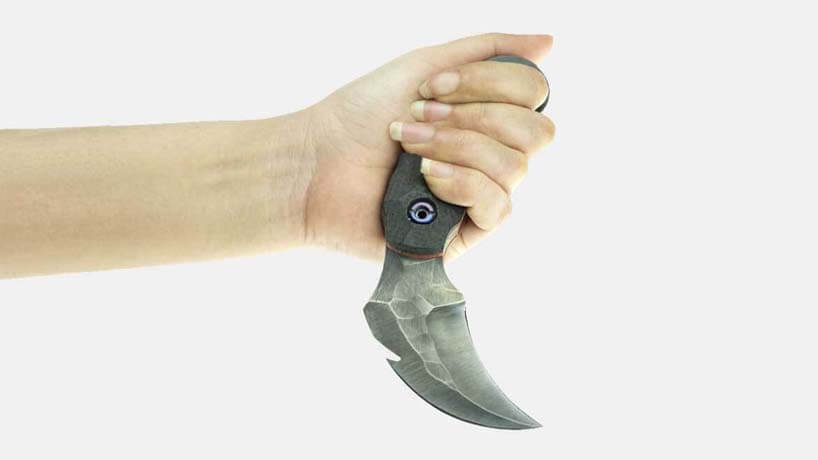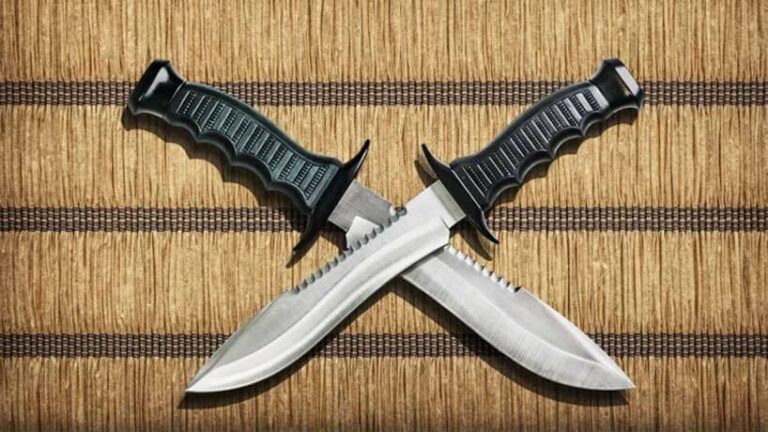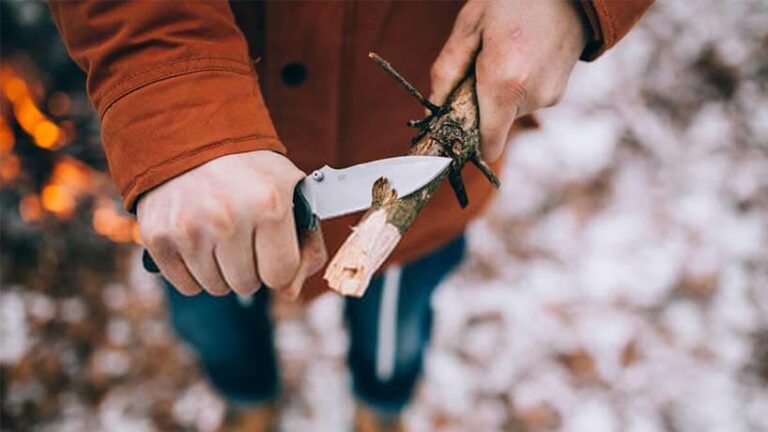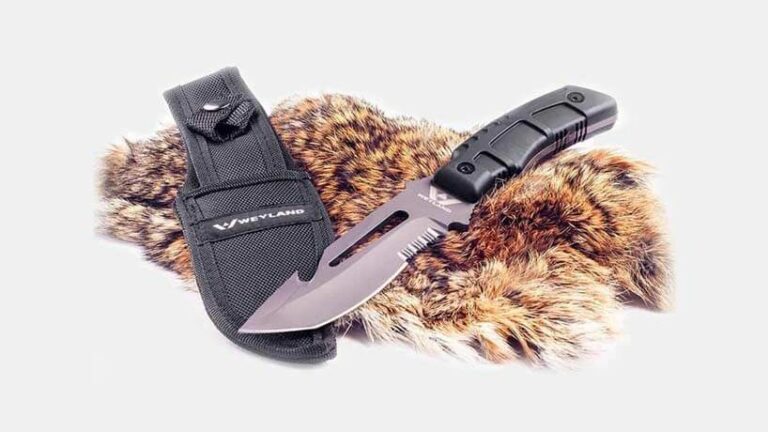If you’ve ever seen an original Karambit knife, you know how intimidating and capable these knives are. Their design and functionality have been refined and perfected over centuries. From the battlefields and farms in Indonesia to the belt of the modern man, these knives have come a long way. We’ll go into what you should be paying attention to when choosing the next Karambit knife.
You’ll learn if they are a good fit, and how you can get a knife that plays to your strength. A large part of choosing the perfect knife for you is to know its strong and weak points – as well as your own. We’ll show you how to use a Karambit knife the right way, how to get better performance from your knife – and how to decide when to use these ancient tools. Let’s get started!
What Is a Karambit Knife?
A Karambit knife is a crescent moon-shaped knife that you wield with one hand. Its unique shape and often double-sided blade give it excellent slicing and defensive ability. Despite this intimidating design, these knives can also make a fantastic utility knife – even though their shape makes them a little unusual to carry.
Karambit knives originated in Indonesia and were used for farming and handiwork, fighting and defense. Their versatility and ease of use made them incredibly popular, and it’s this popularity that eventually led to these knives being used all around the world. Today, you’ll find Karambit knives on the belts of workmen and knife enthusiasts all around the globe.
Their design and function are interpreted differently to fit modern times and can even be found in foldable variants. Perhaps the most distinctive feature of a Karambit is the inner-side cutting edge. While most curved blades today have the cutting edge on the outer curve of the blade, the Karambit has its longest cutting edge in the inside curve.
It leads to a very sharp tip that suits different types of knife grips. Most fixed-blade Karambits have a double-sided cutting edge – though the reverse side’s cutting edge isn’t as long as the inner side’s. The entire inner edge of the knife is sharpened. You can get very consistent and broad cuts with a single slice or motion.
Most Karambit knives have a finger ring at the base of the handle for your thumb or pinky (depending on whether you have a blade-down or blade-up knife grip). Genuine Karambit knives have a curved handle (and blade) that follow the same curvature. This design make these Karambit knives attractive collectors’ items, excellent self-defense knives, or versatile utility options.
What Are Karambit Knives Used for?

As we’ve already hinted at, Karambit knives are incredibly versatile. They’re used anywhere from self-defense knives, martial arts, utility work, and more. While the odd curved shape and larger size (especially the fixed blade variants) make them a little harder and non-standard to carry, these knives can be used for almost anything your standard folding knife can do.
It’s important to note that Karambit knives aren’t designed to have strong piercing power. They’re slicing knives, and they slice more efficiently than almost anything else (at the same size/weight range). The lengthy inner-side cutting edge is extremely sharp and easy to cut with. This is made even better by the razor-sharp tip and double-sided cutting edge.
You’ll find these knives to be adept at basic utility work like opening boxes, stripping wires, and loads more. Karambit knives are used in various martial arts forms such as Silat to teach knife-wielding techniques and related movement. Karambits truly stand out when it comes to self-defense or protection. This is where they shine!
The double-sided cutting edge and wicked sharp tip make these excellent knives effective for quick and deadly slicing motions. You can hold the Karambit blade in various knife grips, but the forward and reverse variants are the best suited to the design and profile of most Karambit knives.
You can get quick and easy slices in different directions without having to expose much of your arm or body. The quick access to the fixed-blade Karambit means you’ll have the blade out and ready in no time. With a little practice, you can draw the knife and move straight into a slicing or guarding position in a single motion.
Much Easier Than It Looks…
Thankfully, the skill ceiling for Karambit knives is quite low and they’re very easy to learn to use and build muscle memory with. If you’ve never used curved blades with an inside cutting edge, then it might take you a little longer to get used to the new shape and curved handle. Once you do though, Karambits are extremely reliable and effective for both utility and self-defense!
The Pros and Cons of Carrying a Karambit Knife
Probably the most immediate issue you’ll come across when carrying a Karambit is its shape. Remember that both the handle and the blade are curved, and this isn’t very common in the single-handed knife world. You’ll take a while to get used to the curved handle and to find the grip techniques that work best for you.
We’ll talk more about how to use a Karambit in the next section – so stay tuned for that. Other than the shape, most Karambit knives are fixed-blade and quite weighty. You can find folding Karambit knives, though they aren’t nearly as common as the fixed-blade option. If you want something compressed and easy to use, then you might want to go with the folding Karambit.
You’ll lose some functionality and versatility as most foldable Karambit knives don’t have double-sided cutting edges. They make up for this with quick-deploying blades and lighter bodies. If you’re looking for a defensive blade, you should probably stick with fixed Karambit blades as they’re sturdier and more reliable.
Also think how to physically carry the knife. Their odd curved shape makes them a nightmare to strap to a belt or sheath. You shouldn’t be carrying these knives as EDC options as their bulk and shape make it harder for them to compete with other EDC knives. The last point to think about is maintenance and care.
Inner-side sharpened blades are notoriously hard to sharpen and require quite a bit of skill to do right. You’re going to need specialized tools specific to sharpen the Karambit. It will take a while to get the technique down, but once you do, it’s not as bad as it sounds.
How to Use a Karambit Properly
First, you need to learn how to hold a Karambit – and this depends on how you’re planning on using it. As we’ve already briefly spoken about, there are two main ways to hold the Karambit: the standard forward grip; and the standard reverse grip. You can rotate the knife 180° in each of these grips, though the most effective way to hold it is with the curve pointing away from your body.
This helps make good use of the sharp tip and efficient inner-side cutting edge. Remember that a Karambit is designed to be excellent at slicing. When you’re using the knife for utility work, try to use the whole inside edge of the blade. You’ll get more consistent and accurate cuts.
The same applies to self-defense movements, make sure your strikes use as much of the inside edge and tip as possible. The reverse side of the blade is sharpened for quick reverse swipes. It’ll take some practice to get these maneuvers down, but they’re not difficult to learn. When you’re learning to use the curved handle of the Karambit, don’t forget to use the finger ring.
If you’re holding the knife in the standard forward grip, slip your pinky through the finger ring. If you’re holding the knife in a reverse grip, slip your pointer (index) finger through the ring. This helps you get a better handle on the curved grip, stop the double-sided blade from slipping and cutting your hand, and improves your slicing and cutting power.
How to Choose the Best Karambit Knife for You?

Take 10-minutes to write down what’s most important to you in a Karambit in terms of price, size, fixed vs foldable, steel quality, weight, sheath (if available), carrying options, cutting edge (double-sided), and whatever else you’d consider. When you go through your options, rank these features according to their importance, and use this as a scale for choosing the perfect Karambit.
Speak to some friends or colleagues that have experience with Karambits and ask them what to look for. It’d also be wise to pay a visit to a local knife store and test out a couple of options. If you do all this, you’ll have a solid foundation to work from. And you’ll end up with a Karambit that’s just right for your style, budget, experience, and planned uses.
Now that you know how to use a Karambit the right way, put that awareness into practice. Hopefully, your next Karambit knife will be one of the best knives you ever use and own!







